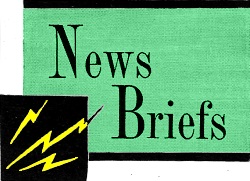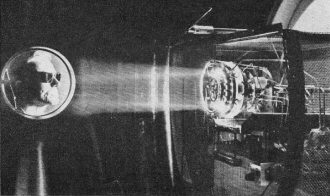|
December 1961 Radio-Electronics
 [Table of Contents] [Table of Contents]
Wax nostalgic about and learn from the history of early electronics.
See articles from Radio-Electronics,
published 1930-1988. All copyrights hereby acknowledged.
|
A lot was happening in
the worlds of science and engineering at the end of 1961. The Space Age was in its
early days, and everyone was excited about the new opportunities access to space
would provide. At the top of the list in this Radio-Electronics
magazine "News Briefs" feature was the tragic death of klystron co-inventor Sigurd
Varian of
Varian Associates. Although not as widely reported as "The Day the Music
Died" with the airplane crash and death of Buddy Holley, Ritchie Valens, and
The Big Bobber, Varian's demise was a sad day for the RF engineering community.
The 55th anniversary of commercial broadcast was noted, as was the FCC's nixing
of any plans for stereo AM radio broadcasting (stereo FM was rapidly overtaking
AM as the primary listening medium). Also, the U.S. Air Force had recently
scattered 350,000,000 tiny copper "hairs" (wires about 0,7" long) into orbit
2,100 miles above the Earth.
New Briefs:
11/1957
| 8/1958 |
11/1959 |
2/1960 |
4/1960 |
8/1960 |
3/1961 |
5/1961 |
6/1961 |
12/1961 |
3/1963 |
4/1963 |
8/1963 |
9/1963 |
8/1964 |
12/1964 |
1/1967 |
3/1967 |
4/1967 |
9/1967 |
4/1968
News Briefs
 Klystron Inventor Killed Klystron Inventor Killed
Sigurd F. Varian, co-inventor of the klystron tube, was killed in a recent plane
crash in the Pacific about a mile off the coast of Mexico. Mr. Varian, with his
late brother Russell and Dr. William Hansen, founded Varian Associates in Palo Alto,
California, to develop and manufacture microwave components. The klystron tube, developed
as a detector of microwaves in 1939, led to the development of microwave radar as
one of the vital weapons in the defense of Britain during World War II.
Spacecraft Not Germ Carriers
The vacuum of space is likely to kill bacteria and fungi, if pressures are low
enough and the exposure is prolonged, declares Charles G. Walance, manager of the
Hughes Aircraft Co. components and materials laboratory. Experiments made at the
laboratory show that micro-organisms can survive relatively high vacuums, giving
rise to the opinion that they can live in space. But if more realistic space conditions
were approximated, they were unable to survive. All micro-organisms were killed
in a 30-day "flight" at a pressure equal to that about 300 miles above the earth.
Even a shorter flight in real space might be fatal to germs, researchers believe.
In real space, they would be subject to ultraviolet and other radiation as well
as vacuum. At any rate, sterilization of moon rockets is unnecessary. Any surviving
micro-organisms landing on the moon would be killed by the high vacuum there.

Practical Ion Engine May Give Us Edge in Space
A working ion engine, demonstrating principles that might eventually send a spacecraft
to Mars at 2,000,000 miles a day, was shown to science and technical writers at
the Hughes Aircraft Co. research laboratory at Malibu, Calif. Newsmen were shown
the engine actually operating in a vacuum chamber which duplicates as closely as
possible the conditions which the engine will encounter in space.
Hughes scientists said that an actual test of the engine in space is planned
for 1962. Asked how soon we might expect a space ship to make the round trip to
Mars, they suggested 1975 01' 1980 as a reasonable estimate.
The principles of ion propulsion were outlined in detail by Prof. Hermann Oberth
in a two-article series "Electric Space Ships" in Radio-Electronics in December
1950 and January 1951. Briefly, a propellant, usually cesium, is stored in a reservoir
from which cesium vapor is diffused through a hot tungsten element which ionizes
the cesium by contact ionization. There then follows a system of electrodes to which
voltage is applied to accelerate the ions to a very high exhaust velocity.
Finally, the high-velocity ion beam passes through a neutralizer region in which
electrons are injected into the beam to neutralize the positive charge of the cesium
ions. It is necessary to emit electrons at' exactly the same rate as ions. If only
the positive ions were ejected, the spacecraft would become highly charged negatively,
until it pulled the ions back to the ship (or the ship back to the ions). It is
also necessary, the Hughes scientists explained, that the electrons and ions be
intimately mixed very close to the vehicle to neutralize the charge everywhere in
the beam. Otherwise, the thrust can be reduced greatly by beam divergence and return
of unneutralized portions of the beam to the ship.
The great advantage of the ion engine is economy-it will drive a ship 20 or 30
times as far as will a chemical rocket engine with the same amount of fuel. Its
disadvantage is that it does not have enough thrust to get a ship out of the earth's
gravity, and thus must have a rocket booster or start from a space platform or satellite.
Do-It-Yourself Ionosphere Is Radio Engineers' Plan
A scheme for creating electrically charged clouds in the region between 40 and
250 miles above the earth and sustaining their charge for hours with radio power
pumped from below has been announced by a team of Sperry Gyroscope Co. engineers.
The charged clouds would make excellent reflectors that could be used to extend
the range of TV stations beyond line-of-sight, to act as midpoint reflectors for
long-distance radio relays, and even to substitute for satellites in transoceanic
broadcasts.
The Signal Corps has set up an artificial cloud of powdered cesium carbonate
which was used to bounce a 100-mc signal between Texas and Florida. The reflecting
patch lasted only a half hour. The Sperry engineers, though silent for patent reasons
on the details of their plan, believe they could ionize such a cloud from below
without using impractical amounts of power.
Broadcasting 55 Years Old
Dec. 24, 1961, marks the 55th anniversary of the first radio broadcast. Speech
and music were transmitted by high-frequency alternator from Brant Rock, off the
coast of Massachusetts, to an audience composed largely of ship operators. Sponsor
of the broadcast was wireless pioneer Reginald Fessenden and his National Electric
Signaling Co. Fessenden reported on the 1906 broadcast:
"The program on Christmas Eve was as follows: first a short speech from me saying
what we were going to do, then some phonograph music. Then came a violin solo by
me, a composition of Gounod called 'O Holy Night,' and ending up with the words
'Adore and be still' of which I sang one verse, in addition to playing on the violin,
though the singing of course was not very good. Then came the Bible text 'Glory
to God in the highest and on earth peace to men of good will' and finally we wound
up by wishing them a Merry Christmas and then saying that we proposed to broadcast
again on New Year's Eve."
The transmitter was a rotating high-frequency AC generator, operating at about
80 kc. The antenna was an "umbrella" type on a tower 400 feet high.
No Stereo AM, Says FCC
There is little evidence of public need or desire for AM stereo, the FCC stated
in turning down petitions from Philco, RCA and Kahn Research Laboratories, who wished
to see standards established for an AM stereo system.
An AM stereo system with sufficient separation and without bad side effects would
be much harder to realize than was the case with FM, the commission pointed out.
Also, the pattern of operation and the needs and purposes served by the nearly 4,000
AM stations are such that the beneficial effects of such an innovation as stereo
would be small.
Radar "Angels" Have Wings
The "angels" on radar screens - those mysterious blips that have puzzled scientists
and radar operators for years - are (as ornithologists have suspected for a number
of years) migrating birds. This solution of a 20-year-old problem was proposed by
three ornithologists in the October, 1961, issue of Natural History, a publication
of the American Museum of Natural History. In experiments on the coast of Massachusetts,
filters designed to remove objects the size of migrating birds filtered the "angels"
out completely.
Besides solving a puzzle that was first posed when British operators noted the
strange blips on their screens in 1940 and 1941, the scientists believe they have
added a new tool in the study of bird migrations. Already they have discovered that
the actual patterns of migratory birds are often quite different than they appeal
to a ground observer.
Copper Hairs Into Space
A 75-lb. air force instrument package spewed three hundred and fifty million
tiny copper hairs into orbit around the earth October 21. Arranged in a band 2100 miles
up, the little wires, about a third the thickness of a human hair and only 0.7 inch
long, are expected to act as tiny dipole antennas for reflecting radio signals.
Tests of 8,000-mc signals between radar antennas at Parks Air Force Base in California
and Millstone Hill, Westford, Massachusetts, via the copper wire belt will be made during
the anticipated 3-year useful life of the particles.
Posted January 11, 2022
|








 Klystron Inventor Killed
Klystron Inventor Killed 
